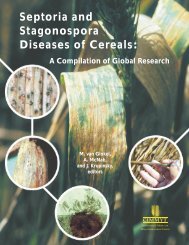Section 3 (Crop Management)
Section 3 (Crop Management)
Section 3 (Crop Management)
You also want an ePaper? Increase the reach of your titles
YUMPU automatically turns print PDFs into web optimized ePapers that Google loves.
Proceedings of the 8 th Asian Regional Maize Workshop, Bangkok, Thailand: August 5-8, 2002<br />
Tillage Practices in Corn Production<br />
Romeo V. Labios 1 *, Jocelyn D. Labios 1 , Leonardo L. Tamisin Jr. 1 , Manuel Q. Esguerra 1 ,<br />
Romulo C. Cambaya 2 , Jupiter S.Tividad 3 and Jasper O. Manalo 4<br />
1 Farming Systems and Soil Resources Institute (FSSRI), College of Agriculture (CA),<br />
University of the Philippines Los Baños (UPLB), College, Laguna 4031<br />
2 BIARC DA-RFU 5, Pili, Camarines Sur;<br />
3 OPA San Jose, Mindoro Occidental;<br />
4 Monsanto Philippines, Inc, E-mail: rvl@lgn.csi.com.ph<br />
Abstract<br />
The potential of conservation tillage systems to improve corn yields while reducing production costs<br />
and conserving soil and water resources was tested through on-farm trials in two sites, namely: San Jose,<br />
Mindoro Occidental and Calabanga, Camarines Sur. A total of 9 farmer-partners cooperated in the<br />
conduct of the trial. Treatments include conventional tillage, minimum tillage, zero tillage and farmer’s<br />
tillage practices, which are tested in factorial with variety or fertilizer. Results in Mindoro reveal that<br />
variation in grain yield is mainly due to tillage practices. Moreover, conservation tillage practices i.e.,<br />
zero and minimum tillage, resulted to the higher grain yield of about 5.29 t ha -1 in Mindoro. In the case of<br />
Camarines Sur, yield was not significantly affected by any of the treatments combinations applied (tillage<br />
x variety). Zero tillage obtained higher grain yield (2.88 t ha -1 ) followed closely by minimum tillage with<br />
2.79 t ha -1 . From these trials it is evident that conservation tillage management generally resulted to<br />
higher grain yield compared with the farmer’s tillage practice. Conservation tillage practice is thus a<br />
viable option for corn production. Benefits obtained in adopting conservation tillage will be further<br />
realized in terms of economic returns, where highest net benefit is obtained due to lower production costs.<br />
In addition, when the soil surface is left undisturbed, soil moisture is conserved at a time when dry<br />
periods are a problem.<br />
Introduction<br />
Land preparation is one of the major farm operations which require considerable labor or capital<br />
resource that farmers are willing to invest in. Tillage operations are performed to create a suitable soil<br />
condition for seeding and further establishment of the crop. Conventional tillage systems consist of a<br />
series of plowing, harrowing and disking to produce a fine seedbed and provide an environment free of<br />
weeds. Depending on the intensity, it is also known that this operation is a cause of soil erosion especially<br />
in sloping lands, soil structure destruction and soil water loss (via evaporation and runoff). Further,<br />
intensive tillage systems result to a decrease in soil organic matter and biodiversity (Biamah et al., 2000).<br />
Tillage practices contribute greatly to the total labor cost in any crop production system resulting to lower<br />
economic returns (Labios et al., 1999). Hence, conservation tillage practices, such as zero and minimum<br />
tillage, may be introduced to offset the production cost and other constraints associated with land<br />
preparation. Reduced or conservation tillage systems are gaining more attention in recent years with the<br />
rising concern over natural resource degradation.<br />
Conservation tillage is the practice of limiting the intensity and frequency of tillage operation while<br />
retaining plant residues in situ. It also decreased the time and power required for crop establishment with<br />
reduction in or complete elimination of the number of tillage applied (Triplett, 1976). Further, when the soil<br />
- 296 -









